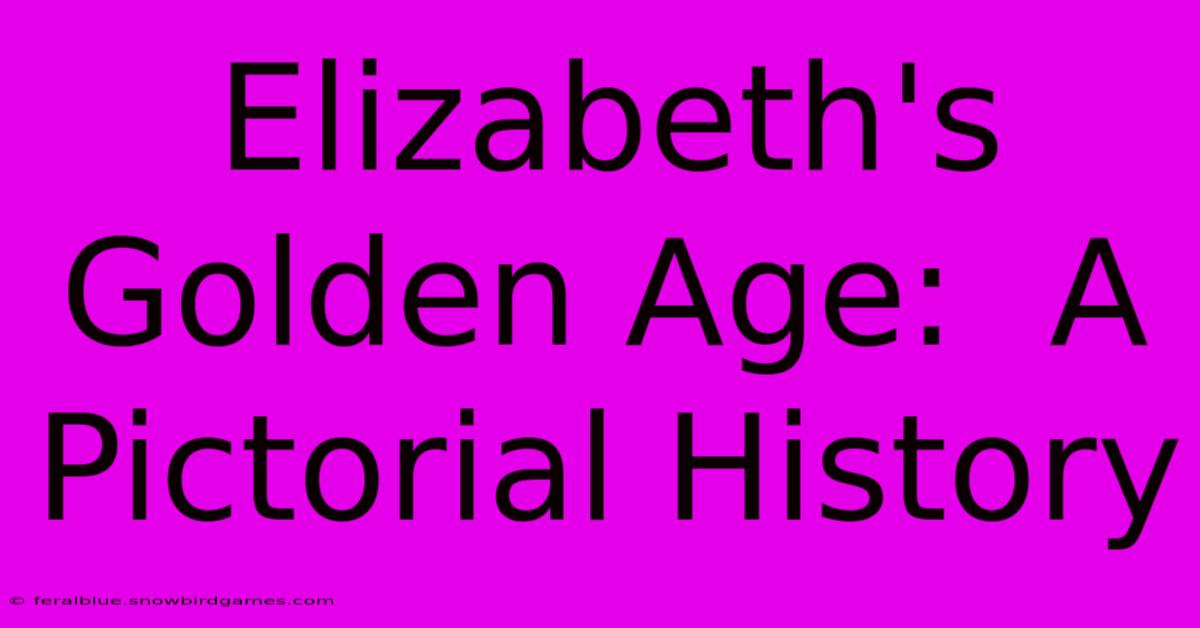Elizabeth's Golden Age: A Pictorial History

Table of Contents
Elizabeth's Golden Age: A Pictorial History
The reign of Queen Elizabeth I (1558-1603) is often romanticized as England's "Golden Age," a period of unprecedented cultural flourishing, exploration, and political stability after years of religious turmoil. This pictorial journey delves into this fascinating era, showcasing the vibrant tapestry of life during Elizabeth's remarkable rule.
A Portrait of Power: The Queen and Her Court
Elizabeth I, a shrewd and complex figure, carefully cultivated her image. Portraits, many commissioned by herself, presented her as a powerful, regal, and even divinely appointed monarch. These weren't mere likenesses; they were powerful statements of her authority and legitimacy. We see her in elaborate gowns, adorned with jewels, a symbol of England's growing wealth and influence. Her carefully crafted image, projected through these portraits, played a significant role in maintaining her control and securing her position.
Beyond the Queen: The Faces of Elizabethan England
Beyond the queen herself, countless portraits capture the lives of the courtiers, nobles, and even ordinary people who inhabited Elizabethan England. These paintings offer a glimpse into the fashions, social hierarchies, and the diverse characters that made up this dynamic era. Note the details: the fabrics, the hairstyles, the expressions – they reveal a wealth of information about the lives and times of those depicted. The portraits serve as a visual diary, capturing individual personalities within the broader context of the age.
Exploration and Expansion: A New World Emerges
Elizabeth's reign witnessed a period of immense exploration and expansion. The era saw the rise of renowned explorers like Sir Francis Drake, whose daring voyages circumnavigated the globe, significantly boosting England's prestige and trade. Illustrations of ships setting sail, depictions of encounters with indigenous populations, and maps charting newly discovered lands illustrate this exciting period of global discovery. These visual representations highlight the ambition, risk, and rewards associated with England’s burgeoning maritime power.
The Impact of Exploration: Trade and Cultural Exchange
The consequences of exploration went beyond simple geographic discovery. The influx of goods from the New World transformed English markets and sparked significant cultural exchange. Images of exotic goods, spices, and the introduction of new crops highlight the economic transformation that occurred during this period. This expansion had far-reaching implications, shaping the economic and social landscape of Elizabethan England.
A Flourishing of the Arts: Literature, Theatre, and Music
Elizabethan England was a golden age for the arts. The plays of William Shakespeare remain some of the most celebrated works of English literature. While we have no surviving visual representations of Shakespeare's productions, paintings depicting theatrical scenes, along with illustrations from contemporary publications, offer a glimpse into the vibrant theatrical world of the time. The era also witnessed the flourishing of music and other artistic pursuits, reflecting the cultural richness of the period.
Shakespeare's Enduring Legacy
Shakespeare's plays, while not directly represented visually in their original performances, have been depicted and re-interpreted countless times since. Examining these later visual representations — paintings, engravings, and even modern film adaptations — reveals how his work has continued to resonate throughout history, shaping our understanding of the Elizabethan era.
Religious Reform and Political Intrigue
Elizabeth's reign wasn't without its challenges. The religious tensions between Catholics and Protestants remained a significant factor throughout her rule. Images reflecting the religious controversies, depictions of courtly life, and portrayals of political events offer insight into the complexities and struggles of the time. The careful navigation of these issues was crucial to Elizabeth’s successful, long reign.
Maintaining Stability: A Delicate Balance
Elizabeth cleverly maintained a delicate balance between the various factions, preventing a return to religious conflict and preserving relative political stability. Her portraits, frequently accompanied by allegorical imagery, were a powerful tool in this process, showcasing her authority and the stability she represented.
Conclusion: A Legacy of Influence
Elizabeth's Golden Age left a lasting legacy on English culture, politics, and global affairs. Its impact is still felt today, making the study of this remarkable period essential to understanding the development of England and the wider world. Through the visual record – the portraits, maps, and artistic representations – we can gain a deeper appreciation for the richness, complexity, and enduring influence of Elizabeth I's reign.
Keywords: Elizabeth I, Elizabethan Era, Golden Age, England, Portraits, Exploration, Sir Francis Drake, William Shakespeare, Religious Reform, Political Intrigue, Cultural Flourishing, Maritime Power, Renaissance, Art, Literature, Theatre, History, Pictorial History.

Thank you for visiting our website wich cover about Elizabeth's Golden Age: A Pictorial History. We hope the information provided has been useful to you. Feel free to contact us if you have any questions or need further assistance. See you next time and dont miss to bookmark.
Featured Posts
-
Dr Umars Daughter Her Creative Pursuits
Apr 06, 2025
-
Gautam Gambhir At Age Still Making Headlines
Apr 06, 2025
-
Age Of Empires 3 Hile The Only Guide You Ll Ever Need
Apr 06, 2025
-
Mick Schumacher Battling Expectations
Apr 06, 2025
-
Endricks Wifes Age Is It Relevant
Apr 06, 2025
